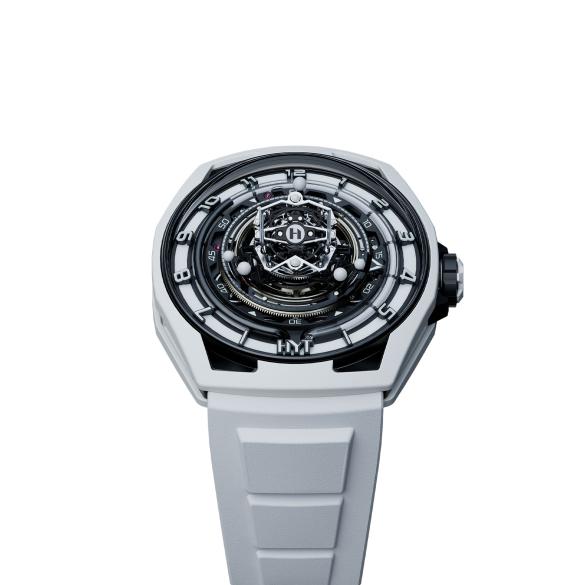After a recently released white Panda version it is time for the HYT Conical Tourbillon Infinity Diamonds, so with lots of glitter
Titanium
Titanium is a chemical element with the symbol Ti and atomic number 22. It is a lustrous transition metal known for its strength, low density, and corrosion resistance. It is often alloyed with other metals to enhance its properties, and these alloys are widely used in various industries.
.
What are the characteristics of titanium ?
.
Strength and Low Density: Titanium is known for its high strength-to-weight ratio, making it a valuable material in applications where lightweight strength is crucial, such as aerospace engineering.
.
Corrosion Resistance: it has excellent corrosion resistance, even in challenging environments. This property makes it suitable for use in chemical processing, marine applications, and medical implants.
.
Biocompatibility: it is biocompatible, meaning it is generally well-tolerated by the human body. This makes it a common material for medical implants, such as artificial joints and dental implants.
.
High Melting Point: it has a relatively high melting point, contributing to its ability to withstand high temperatures. This property is beneficial in applications like the aerospace industry.
.
Versatility in Alloys: Titanium is often alloyed with other metals, such as aluminum, vanadium, and iron, to create alloys with specific properties tailored to particular applications.
.
Corrosion Resistance: Titanium exhibits excellent resistance to corrosion, even in aggressive environments. This makes it valuable in applications where resistance to corrosion is crucial.
.
Common uses of titanium include aircraft components, spacecraft, naval ships, medical implants, sporting equipment, and chemical processing equipment. While titanium is abundant in the Earth’s crust, its extraction and processing can be challenging, contributing to its relatively high cost compared to other metals.
.
How hard is titanium?
.
The Vickers hardness (HV) of titanium used in watches varies depending on the specific alloy and whether it has been heat-treated. Here are typical values for titanium in watchmaking.
.
The first is grade 2 titanium (commercially pure titanium), with 150 to 200 HV, comparable with 316L stainless steel. It not extremely hard but very lightweight and highly resistant to corrosion, making it a popular choice for watches.
.
Grade 23 is the second value. Grade 23 titanium, also known as Titanium 6Al-4V ELI (Extra Low Interstitial), has a Vickers hardness (HV) ranging between 250 and 330 HV. This titanium alloy is favored in high-performance applications due to its excellent strength-to-weight ratio, biocompatibility, and superior corrosion resistance. It is commonly used in aerospace, medical implants, and premium watch cases.
.
Another grade often used is grade 5 titanium (Ti-6Al-4V), a titanium alloy with aluminum and vanadium. This has a Vickers hardness of about 300 to 400 HV, so it is much harder than grade 2 titanium and is often used in high-end or sport watches. Just because it offers a good balance between hardness, strength, and corrosion resistance. But it’s also more expensive, so sometimes watchmakers combine the two grades.
.
While titanium is not as hard as materials like ceramic or sapphire, it is much lighter and offers excellent resistance to wear and corrosion. Making it a favorite for watch cases and bracelets. And some brands apply surface treatments (like DLC coating) to further increase the hardness and scratch resistance.
.
Compare case materials on the Hardness Vickers scale (from hard to hardest):
.
| Carbon | 20-50 HV |
| Platinum | 40 HV (950 platinum: 80-135 HV) |
| Silver | 70-90 HV |
| Bronze | 60-150 HV (100-200 HV treated) |
| Aluminium | 120-200 HV |
| Gold | 120-200 HV (18k or 14k) |
| Palladium | 150-200 HV |
| White gold | 150-250 HV |
| Stainless steel | 150-250 HV (special 1200 HV) |
| Titanium | 150-200 HV (grade 2) up to 300-400 HV (grade 5) |
| Ceramic | 1200-1400 HV (1500-2000 for alumina) |
| Sapphire | 2000-2300 HV |
.
Watches from titanium
Roger Dubuis Excalibur Spider Flyback Chronograph Lamborghini Verde Mantis
The Roger Dubuis Excalibur Spider Flyback Chronograph Lamborghini Verde Mantis is inspired by Lambo’s SC63 Le Mans 2024 car
The Roger Dubuis Excalibur Monotourbillon Titanium is another variant of RD’s Monotourbillon theme, now available in titanium
Super light and super shock-resistant is what makes the Richard Mille RM 27-05 Flying Tourbillon Rafael Nadal unique
The Louis Moinet Geopolis Opal is a one-off timepiece by the Swiss brand and focusses on the use of colorful opal on a black background
The Ulysse Nardin Diver x Skeleton Ops is one of two new tough looking green divers of UN, here with an open-worked dial and skeletonized parts
The masters of fluidic watchmaking mechanics present the HYT Conical Tourbillon Panda, a white with black timepiece with unique features
Since 1969 TAG has a Monaco model and this new TAG Heuer Monaco Chronograph Dark Blue still has the classic design
The F.P. Journe Chronographe FB is the sixth and last model of the Tokyo Boutique Anniversaire Series, which started 20 years ago
The full Panerai signature design packed in carbon; this is the Panerai Submersible Tourbillon GMT Luna Rossa Experience Edition









